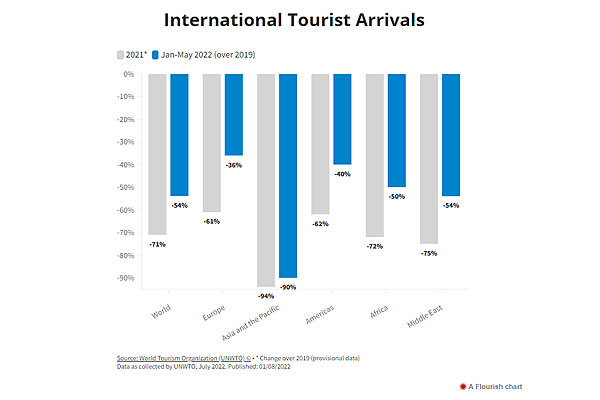According to the latest UNWTO World Tourism Barometer, international tourism saw a strong rebound in the first five months of 2022, with almost 250 million international arrivals recorded. This compares to 77 million arrivals from January to May 2021 and means that the sector has recovered almost half (46%) of pre-pandemic 2019 levels.
International tourism continues to show signs of a strong and steady recovery from the impact of the pandemic despite significant mounting economic and geopolitical challenges.
According to the latest UNWTO World Tourism Barometer, international tourism saw a strong rebound in the first five months of 2022, with almost 250 million international arrivals recorded. This compares to 77 million arrivals from January to May 2021 and means that the sector has recovered almost half (46%) of pre-pandemic 2019 levels.
“The recovery of tourism has gathered pace in many parts of the world, weathering the challenges standing in its way”, said UNWTO Secretary-General Zurab Pololikashvili. "At the same time, he also advises caution in view of the “economic headwinds and geopolitical challenges which could impact the sector in the remainder of 2022 and beyond”.
Europe and Americas lead recovery
Europe welcomed more than four times as many international arrivals as in the first five months of 2021 (+350%), boosted by strong intra-regional demand and the removal of all travel restrictions in a growing number of countries. The region saw particularly robust performance in April (+458%), reflecting a busy Easter period. In the Americas, arrivals more than doubled (+112%). However, the strong rebound is measured against weak results in 2021 and arrivals remain overall 36% and 40% below 2019 levels in both regions, respectively.
The same pattern is seen across other regions. The strong growth in the Middle East (+157%) and Africa (+156%) remained 54% and 50% below 2019 levels respectively, and Asia and the Pacific almost doubled arrivals (+94%), though numbers were 90% below 2019, as some borders remained closed to non-essential travel. Here, the recent easing of restrictions can be seen in improved results for April and May.
Looking at subregions, several have recovered between 70% and 80% of their pre-pandemic levels, led by the Caribbean and Central America, followed by Southern Mediterranean, Western and Northern Europe. It is noteworthy that some destinations surpassed 2019 levels, including US Virgin Islands, St. Maarten, the Republic of Moldova, Albania, Honduras and Puerto Rico.
Tourism spending also rising
Rising tourism spending out of the major source markets is consistent with the observed recovery. International expenditure by tourists from France, Germany, Italy and the United States is now at 70% to 85% of pre-pandemic levels, while spending from India, Saudi Arabia and Qatar has already exceeded 2019 levels.
In terms of international tourism receipts earned in destinations, a growing number of countries – the Republic of Moldova, Serbia, Seychelles, Romania, North Macedonia, Saint Lucia, Bosnia & Herzegovina, Albania, Pakistan, Sudan, Türkiye, Bangladesh, El Salvador, Mexico, Croatia and Portugal – have fully recovered their pre-pandemic levels.
Defying mounting challenges
Strong demand during the Northern Hemisphere summer season is expected to consolidate these positive results, particularly as more destinations ease or lift travel restrictions. As of 22 July, 62 destinations (of which 39 in Europe) had no COVID-19 related restrictions in place and an increasing number of destinations in Asia have started to ease theirs.
According to the International Civil Aviation Organization (ICAO), the overall reduction in international air capacity in 2022 will be limited to 20% to 25% of seats offered by airlines as compared to 2019. Such resilience is also reflected in hotel occupancy rates. Based on data from the industry benchmarking firm STR, global occupancy rates climbed to 66% in June 2022, from 43% in January.
However, stronger than expected demand has created significant operational and workforce challenges, while the war in Ukraine, rising inflation and interest rates, as well as fears of an economic slowdown continue to pose a risk to recovery. The International Monetary Fund points to a global economic slowdown from 6.1% in 2021 to 3.2% in 2022 and then to 2.9% in 2023. At the same time, UNWTO continues to work closely with the World Health Organisation (WHO) to monitor the pandemic as well as emerging public health emergencies and their potential impact on travel.
Regional Scenarios for 2022
UNWTO’s forward-looking scenarios published in May 2022 point to international arrivals reaching 55% to 70% of pre-pandemic levels in 2022. Results depend on evolving circumstances, mostly changing travel restrictions, ongoing inflation, including high energy prices, and overall economic conditions, the evolution of the war in Ukraine, as well as the health situation related to the pandemic. More recent challenges such as staff shortages, severe airport congestion and flight delays and cancellations could also impact international tourism numbers.
Scenarios by region show Europe and Americas recording the best tourism results in 2022, while Asia and the Pacific is expected to lag behind due to more restrictive travel policies. International tourist arrivals in Europe could climb to 65% or 80% of 2019 levels in 2022, depending on various conditions, while in the Americas they could reach 63% to 76% of those levels.
In Africa and the Middle East arrivals could reach about 50% to 70% of pre-pandemic levels, while in Asia and the Pacific they would remain at 30% of 2019 levels in the best-case scenario, due to stricter policies and restrictions.
Vicky is the co-founder of TravelDailyNews Media Network where she is the Editor-in Chief. She is also responsible for the daily operation and the financial policy. She holds a Bachelor's degree in Tourism Business Administration from the Technical University of Athens and a Master in Business Administration (MBA) from the University of Wales.
She has many years of both academic and industrial experience within the travel industry. She has written/edited numerous articles in various tourism magazines.




























































































































































































































